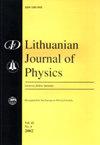Increase of the surface recombination velocity at high bias voltage in silicon irradiated by neutrons to extremely high fluences
IF 0.3
4区 物理与天体物理
Q4 PHYSICS, MULTIDISCIPLINARY
引用次数: 0
Abstract
The upgrading of ionizing radiation detectors is an actual problem especially related to the high energy physics and space research experiments. The simplest way to restore the signal of the irradiation degraded detector is the increase of the detector bias voltage. This method is widely used worldwide, including high energy physics experiments in ATLAS and CMS. This work presents an effect, which was caused by increased bias voltage in detectors irradiated to extreme high neutron fluence at low temperature. The effect could be related to the increase of surface recombination velocity.The intrinsic photoconductivity spectra were exploited in order to investigate the properties of highly irradiated silicon as this effect depends on parameters that are important in radiation detectors. Two characteristic effects were observed in such highly irradiated samples: the increase of photoconductivity quantum yield and the enhancement of surface recombination at higher bias voltages. The increase of the quantum yield was analyzed in Ref. [1]. The increase of the surface recombination with bias electric field was analyzed in this work as an extension of the performed investigation in the same samples as in Ref. [1]. The investigated silicon samples were irradiated by neutrons to wide range fluence up to 1017 n/cm2.The origin of this effect was analyzed and related to the radiation clusters, which decrease the free carrier lifetime.中子辐照到极高通量时硅在高偏压下表面复合速度的增加
电离辐射探测器的升级是一个实际问题,尤其与高能物理和空间研究实验有关。恢复辐射退化探测器信号的最简单方法是增加探测器偏置电压。这种方法在世界范围内广泛使用,包括在ATLAS和CMS中进行高能物理实验。这项工作提出了一种效应,这是由探测器在低温下受到极高中子注量照射时偏置电压增加引起的。这种效应可能与表面复合速度的增加有关。利用本征光电导光谱来研究高辐射硅的性质,因为这种效应取决于辐射探测器中重要的参数。在这种高度辐照的样品中观察到两个特征效应:在较高的偏压下,光电导量子产率的增加和表面复合的增强。参考文献[1]分析了量子产率的增加。本工作分析了偏置电场下表面复合的增加,作为对参考文献[1]中相同样品进行研究的扩展。对所研究的硅样品进行了宽范围中子辐照,通量高达1017n/cm2。分析了这种效应的起源,并与降低自由载流子寿命的辐射团簇有关。
本文章由计算机程序翻译,如有差异,请以英文原文为准。
求助全文
约1分钟内获得全文
求助全文
来源期刊

Lithuanian Journal of Physics
物理-物理:综合
CiteScore
0.90
自引率
16.70%
发文量
21
审稿时长
>12 weeks
期刊介绍:
The main aim of the Lithuanian Journal of Physics is to reflect the most recent advances in various fields of theoretical, experimental, and applied physics, including: mathematical and computational physics; subatomic physics; atoms and molecules; chemical physics; electrodynamics and wave processes; nonlinear and coherent optics; spectroscopy.
 求助内容:
求助内容: 应助结果提醒方式:
应助结果提醒方式:


